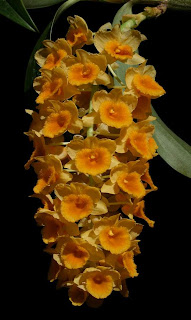 |
| A fully mature flower of Den. densiflorum |
 |
| An inflorescence |
How do I cultivate it.
Light: Full sun most of the morning, dappled sunlight the rest of the day, but much care is taken that the plant is not so exposed as to get sunburn.Temperature: 85F day in summer with a 10F degree drop at night, 75F day between September and April with a 10F degree drop at night.
Watering: Daily when it is producing new growth, when new growth matures all supplemental watering is suspended and it only gets water when it rains.Fertilizer: Weekly diluted 20-20-20 when it is in full growth, none after the cane matures. Organic fertilizer is also used to help the canes to plump up.
Humidity: The climate supplies a humidity level from 70 to 80 percent during the day.
Media: Medium sized bark.Potting: The middle tube of a plastic soda bottle was used, the media was held in by a very open wire bottom that allows for decayed media to fall.
Repotting: The plant was allowed to become pot bound, but it is in need of re potting because the canes have begun to grow against the side of the pot.Seasonality: It gets little special care when not growing or blooming, it gets concentrated care when it is producing new growths as canes grow relatively fast.
This is a magnificent plant that is quite rewarding if you are able to give it the growing conditions it needs. Sadly the flowers are short lived and last only five to six days. I have another plant that was also labeled densiflorum but that has not bloomed even when it achieved a large size. However its canes are deeply furrowed which makes me think it may be thysiflorum. The thyrsiflorum plant grows very well and it’s very hardy but has not shown any inclination to bloom even after ten years under my care.
Pests: Snails and slugs may eat the tender canes but little else seems to bother this plant in my location. Unfortunately the bright color of the inflorescence seems to attract all the thrips in the local area and they will converge of the inflorescence and damage it if it is not protected. (I usually take the plant indoors when its in bloom). Unfortunately thrips seem to find these flowers so alluring that they will wallow through a thick slurry of Sevin dust to sink their thrice accursed mouth parts in the flower, they then die in transports of ecstasy all the while spoiling the flowers with their unsightly little bodies.
A link to the most recent blooming of this species in my collection
http://ricardogupi.blogspot.com/2011/03/dendrobium-densiflorum-revisited-march.html
A link to the most recent blooming of this species in my collection
http://ricardogupi.blogspot.com/2011/03/dendrobium-densiflorum-revisited-march.html











No comments:
Post a Comment